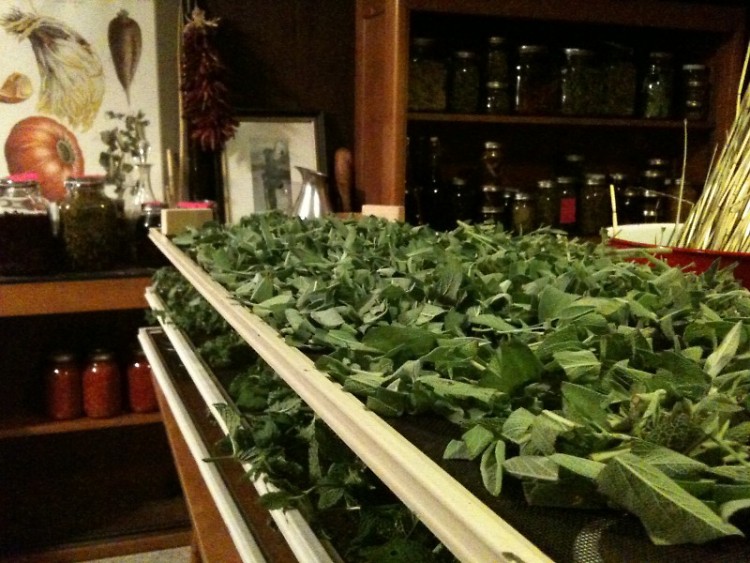For many, the term herbal apothecary evokes images of shelves, bottles and jars all filled with mysterious herbs and herbal formulas from exotic plants.
But to have an herbal apothecary, plants need not be exotic or mysterious - in fact, as more and more people look local plants and herbs to incorporate into their natural wellness routine, beginning your own apothecary can begin as close to home as the garden. And it need not be a daunting task.
Imagine: your own herbal apothecary filled with local herbs that are gathered from your gardens, the farmers market, and even field hedgerows and woodlands that you can turn to when you feel a cold coming on, an upset stomach after an indulgent meal.
Tips for adding herbs into your garden for harvesting
Many people are going locavore this year and have incorporated vegetables into their outdoor landscapes. Canning is becoming popular, as is pickling and freezing the summer's bounty for winter.
In establishing a supply of herbs for your own herbal apothecary this winter, consider adding perennial kitchen herbs like popular plants such as thyme, sage, mint, bee balm and lavender into your garden plan. These well-known plants will not only offer you a source of fresh culinary herbs throughout the season for cooking, but can be dried for tea for winter's warm sipping.
Thyme, sage, mint, bee balm and lavender are basic garden herbs that are widely available at local greenhouses and can often be found at the farmers markets well into June for purchase as transplants. When selecting transplants for your gardens, be sure to look for plants that have a vital energy and have been started in chemical-free, heavily composted soil.
These herbs prefer full sun in well-drained soil, so consider these needs when integrating the herbs into the flower garden or vegetable garden. And remember, peppermint spreads via underground runners so it might be worth keeping these plants in pots to prevent rampant spreading of mint throughout your other plantings.
Also keep in mind that it's nice to have these culinary herbs close to the kitchen for easy harvesting when cooking. If you don't have a significant area of land in which to garden, the sage, thyme, mint and lavender are all plants that can work in pots as long as they have proper drainage and are filled with compost-rich soil, perfect for the patio or balcony if you are an apartment dweller.
How and when to harvest
In early summer, the flowering tops of sage, thyme and lavender can be easily cut with scissors and can be used to make herbal honey or vinegars. The flower stalks can be bundled and hung to dry simply dried on screens to later be blended together for a soothing aromatic tea blend. An added bonus for cutting back blooms: sometimes an early cutting of the flowers will result in a second bloom. Lavender will often do this if it's a warm summer.
Old-timer wisdom says to harvest aerial parts of the plant (leaves, stems, flowers) as close to the time of the full moon as possible. It's been said that the magnetic pull of the moon brings the plants - along with the tides - nearly an inch higher toward the sky! The plant then has the majority of its energy in its leaves at this time. Wives tale? Maybe. But it's a nice, mindful ritual to add into the harvesting of the plant.
To dry the leaves and stalks for tea, the full stalks can be harvested with scissors or garden pruners nearly at any point in the season. They should be bundled, and hung to dry in a clean, warm dry space. Individual leaves can be harvested and dried on screens. Be sure to harvest the plants after the morning dew has dried, and the plants are full dry before storing in paper bags or glass jars. If the plant is not thoroughly dry before storing there is a high likelihood that the drying plant material will mold in the container. Be sure to always label the paper bags and jars as you put up your herbal harvest.
And while the plants will be at their most vibrant during the growing season, consider collecting any remaining leaves and stalks at the end of the fall when plants are being trimmed back and gardens are being put to bed for the winter. This is an easy way to put away just a few more handfuls of herbs as the cold winter settles.
Thyme, sage, mint, bee balm and lavender are all herbs that are relatively hardy to our climate and the plants will offer a source of herbs well into November or until the snow flies. And sometimes -in a pinch- it's possible to dig through the snow to collect the still-aromatic, woody stems of the sage and thyme or bee balm for a soup or if someone is sick and a tea is needed.
Go beyond the cultivated spaces of the garden
Already got a few basic kitchen herbs in your garden? Head into the fields and forests to try to your hand at gathering wild-grown herbs and flowers.
In July, venture out to the meadows to harvest the wild sister plant to bee balm - wild bergamot (Monarda fistulosa) and yarrow (Achillea millefolium). Collect the flowering stalks, bundle and dry. Sort the flowers, leaves from the woody stems and use for teas. Know of a source of elder (Sambucus canadensis) bushes? Ask around if you don't. They are plentiful in the Great Lakes area. Gather the elderflower in late June by the entire cluster and dry for tea. The wild bergamot, elderflower and yarrow blend well as a tea for the onset of colds (see Burdock & Rose's Gypsy Tea recipe in the sidebar).
Got raspberry bushes? Collect the leaves of either the black or red raspberry (Rubus spp) to make a nutrient-dense tea (high in calcium and vitamins A and C). It is also excellent as a mineral-rich female tonic for women of all ages and can support healthy prostate function. It's also a relaxant and nice to sip before bed. Clip the leaves with scissors. Dry on screens and store in a glass jar.
Using your herbs in your apothecary
Tasting and smelling your freshly harvested herbs will set you on your way to better understanding how plants can be used in times of illness and as part of a regular diet. Take note as to how they taste in tea using both dry herbs and fresh plants. Notice a difference? You will learn ways to prepare the herbs to suit your tastes, and also how they may have an action on the body. So as you continue along your herbal harvest journey, experiment with the herbs singly as a tea or try blending them together!
Over the coming season, you may find that you like working with plants so much you will want to delve into making herbal salves, herbal infused oils and tinctures. You certainly will discover that it is truly satisfying to begin to rely on the natural world for wellness and to connect to a tradition of herbal healing and reliance on plants that is as old as time itself.
The Rapidian, a program of the 501(c)3 nonprofit Community Media Center, relies on the community’s support to help cover the cost of training reporters and publishing content.
We need your help.
If each of our readers and content creators who values this community platform help support its creation and maintenance, The Rapidian can continue to educate and facilitate a conversation around issues for years to come.
Please support The Rapidian and make a contribution today.




Comments
This is a fantastic article Lisa, How do you infuse dried herbs into water. In the mug? In a tea infuser? Bunch in a cheese cloth?
Thanks, Taylor! Great question - it really depends on what and how much of the infusion or tea you'd like to make. If it's just a cupful of mint tea or Gypsy Tea, then a teaball works, or even a cloth tea bag. Often, I make more than a cup and toss herbs into a pot and cover with boiling water to infuse. Be sure to cover the pan, too, with a lid so the aroma of those aromatic teas don't evaporate. I then strain into a mug or thermos using a strainer, or a tea strainer. Sometimes I use a funnel to avoid spilling. Sicilano's on Lake Michigan Drive has an awesome array of funnels and strainers. So do garage sales.